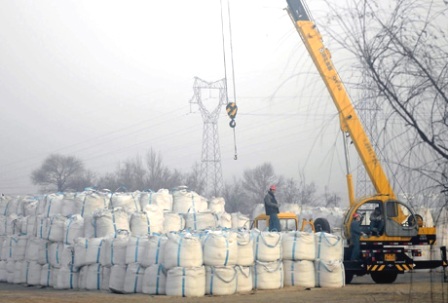
China mines REEs from bastnasite ore in the provinces of Gansu and Sichuan. In Inner Mongolia REEs are obtained as a by-product from iron making.
HREE extraction, based on ion absorption clays, occurs in the states of Guangdong, Hunan, Jiangxi and Jiangsu. These clays have very low cerium content and as a consequence the other REEs, in particular the HREEs, comprise a much larger share of the ore than is found elsewhere.
Currently Chinese ion absorption ore is the main source for HREE and resources are not published. There may be the possibility of discovering new ion absorption deposits in Southeast Asia, however high costs for labor, lack of infrastructure and environmental restrictions may render these new deposits uneconomical when competing in the market place with Chinese output.
China has 36 to 53 percent of the world’s REE deposits (industry figures differ) and supplies 97 percent (this number is constant) of the global demand for rare earth elements. The low cost and unregulated production from China’s large deposits forced the closure of almost every rare earth mine outside of China.
Tighter limits on production and lowered export quotas are being put in place to ensure China has the necessary supply for its own technological and economic needs – in 2006 volume dropped to 48,000 tonnes. In 2007 volume dropped to 43,574 tonnes, in 2008 volume dropped to 40,987 tonnes and in 2009 to 33,300 tonnes. In 2010 China dropped its annual REE export quota by 37% and then announced an additional 35% drop in its H1 2011 export quota.
In a hunt to secure jobs, and access to advanced technologies, the Chinese have forced manufacturers needing access to REEs to make their products in China. These manufacturers must either cut back production or build their factories/products in China – recently major producers of the magnet material Neodymium-Iron-Boron have transferred their operations to China.
Demand for Rare Earths is forecasted to grow at 8-11% per year between 2011 and 2014. Many experts are predicting that the Chinese, and those end users who moved to China for security of supply, will be internally consuming most of the countries rare earth production by about 2014 (forecast demand, source: IMCOA presentation).
Rare earth demand is driven by several global macroeconomic trends:
- Miniaturization
- Environmental protection
- Increasing demand for energy, power and fuel efficiency
The highest demand growth is expected for magnets and metal alloys – hybrid and electric vehicles along with wind turbines (also High Speed Rail) will compete for the essential materials and there are no substitutions for the REEs used in these applications. An increased use of energy efficient fluorescent lights and growing demand for LCDs, PDPs will increase the use of phosphors.
The French Bureau de Recherches Géologiques et Minières rates high tech metals as critical, or not, based on three criteria:
- Possibility (or not) of substitution
- Irreplaceable functionality
- Potential supply risks
It’s very obvious REEs are critical metals and that the west is going to need a secure, long term supply of rare earth elements completely independent of Chinese control.



 Follow us on Twitter
Follow us on Twitter Become our facebook fan
Become our facebook fan










Comments are closed.